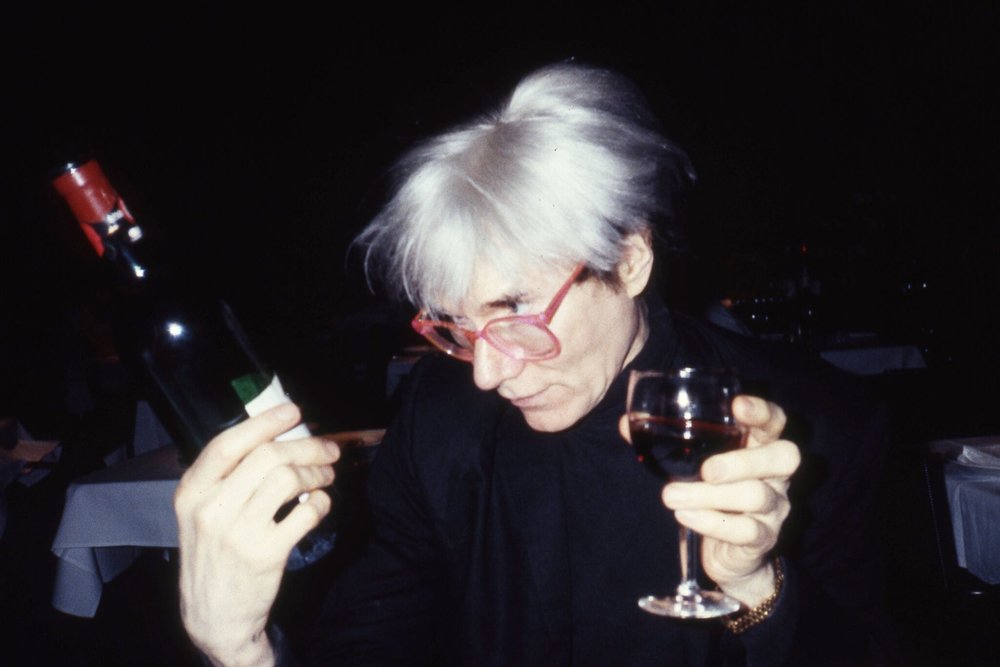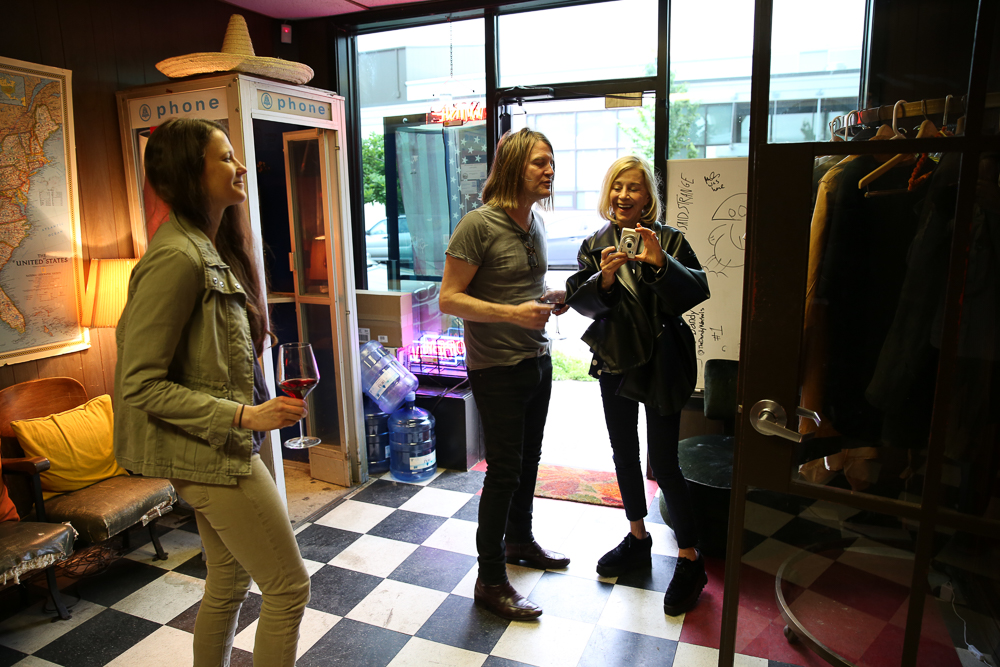D2D Interview: Paige Powell

I was in Portland a few months ago with Courtney Taylor, hosting a big wine tasting at his bar The Old Portland, when I struck up a conversation with a striking and well-dressed woman who sat down next to me, decked out in a sleek faux leather Comme des Garcons jacket and polka dot purse. Courtney had mentioned to me earlier in the day that he was expecting a friend at the party who had once worked with Andy Warhol in the eighties, and—being a huge fan of Warhol and the entire New York scene that unfolded under his stewardship—I was curious as to who it might be. My wife and I have spent countless hours in museums over the years looking at the work of the Factory artists, as well as the pop art of Keith Haring and of course Jean-Michel Basquiat. As two kids who grew up in the eighties and watched MTV religiously, the New York street scene with the birth of hip-hop and graffiti was practically our cultural upbringing. It’s one of the biggest connections we continue to have as a couple. Having gone through a bit of a Basquiat phase over the last few years, I had been looking more into his background and when the woman told me her name was Paige Powell, I about spit out my pinot noir.
Paige Powell not only dated Jean-Michel Basquiat before his tragic death, she helped launch his career by curating shows on his behalf and helping to sell his work early on. She worked at INTERVIEW magazine with Andy Warhol as his assistant and lived through adventures in New York that I can only imagine: Keith Haring, Madonna, Fab Five Freddy, all of it! She was a documenter and continues to be an archivist of that era, hosting exhibitions at galleries with her extensive library of videos and photographs. I could have cornered her for hours and peppered her with an endless assault of queries! While I didn’t want to overwhelm her upon our initial meeting, this was a woman I really wanted to talk to. We made a date to catch up recently and I finally got to ask her all those burning questions that had been building up inside me. Our conversation is below:
David: You’re someone who got to experience what is—in my opinion—the most iconic period in American art/music history: the early eighties in New York. Not only did you live it, you were close with Andy Warhol and Keith Haring, and of course dated Jean-Michel Basquiat for a number of years. Do you look back now and think: “Wow, those were the days!” or do you think people like myself romanticize it into something bigger and better than it was?
Paige: Yes, they really were the days, but I didn’t know it at the time coming from Portland, Oregon, assuming that New York City always had high voltage creativity, energy, diversity and communities of like minded people. It was a romantic urbantopia. We all explored, created and experimented doing exactly what we wanted to do without a ceiling or being fueled by commerce. We were happy just getting by doing what we loved.
David: Since this is supposed to be an interview about drinking, let’s talk about drinking. Where were the coolest bars in New York at that time and what were the popular drinks in your crowd?
Paige: I was uptown, downtown and all around. Harlem had the best nightclubs like Small's Paradise, Beverly Hills Restaurant and Lounge, Casa Blanca, the Press Club, La Famille, Blue Moon and Lenox Lounge. Upper Eastside Bemelman’s Bar at the Carlyle Hotel, Polo Lounge, Le Cirque and Quo Vadis, Upper Westside Café, Luxembourg, Café des Artists, Mr. Chow in Midtown, King Cole Bar at the St. Regis, Barbetta, Lutece, downtown Raoul’s, Florent, Odeon, Nell’s, DaSilvano, Emilio’s Balatto to name a few. So many, many more. Our drinks of choice were red wine, Champagne, Kir Royales, and martinis. We all went out every night to film premieres, art openings, parties, restaurants, clubs, museums, etc. What was considered a special evening was staying in at home.
 Andy Warhol with a glass of red circa 1985. This photo was taken by Paige Powell and is ©Paige Powell. Any reproduction of this photograph is strictly prohibited without the express permission of Paige Powell ArchiveDavid: Who were the biggest martini drinkers in your circle? Did anyone have an affinity for one thing?
Andy Warhol with a glass of red circa 1985. This photo was taken by Paige Powell and is ©Paige Powell. Any reproduction of this photograph is strictly prohibited without the express permission of Paige Powell ArchiveDavid: Who were the biggest martini drinkers in your circle? Did anyone have an affinity for one thing?
Paige: Andy Warhol wasn’t much of a drinker but he did like a vodka martini straight up or on occasions red wine. Michel Roux, who was the CEO of Carillon Importers, had Absolut as a brand. They were Andy’s biggest advertisers for his INTERVIEW magazine. Andy and I would periodically have dinner with Michel and talk about his brands and art. Absolut Peppar had been recently introduced so Michel asked Andy if he had tried it and if so what did he think. Andy replied “Yes. I think it’s great. It’s great. I love wearing it.”
David: I would have killed to go to Mr. Chow back in the day. What was the scene there like? What would you guys eat and drink?
Paige: The room was and is still like a gorgeous and dramatic theatre with beautiful lighting, warm, welcoming and always terrific liveliness and fun. It was a favorite hangout for artists. We rarely ordered off the menu having the chef concoct a variety of dishes for our table. My favorite were the mounds of crispy spinach seaweed and the black mushrooms. I’ve been vegan for twenty six years, but I know that I ate fish at Mr. Chow earlier. We would all have a ritual Kir Royale: it was pretty, delicious, elegant, festive and it tasted fancy. Then we moved on to Champagne and red wine. Andy Warhol and I started a blind date club with our friend Tama Janowitz and we often entertained there. After dinner, there was always lots of uneaten food left and Andy would have the servers pack it up and as we walked west on 57th to head uptown, he’d leave it on the corner next to a garbage bin for a homeless person.
David: I also remember you pointing out to me that your awesome leather jacket was actually faux leather. Are you an animal lover?
Paige: I'm a long time animal activist and I support numerous local and global animal welfare issues. I think it would be a better world for all if people stopped eating meat.
David: Today you’re back living in Portland, your hometown, and you’re still involved with the art scene there. How have your tastes in beverages changed over the years and what do you prefer today?
Paige: I’m a red wine appreciator and I love the many wonderful Oregon pinot noirs just twenty-five miles from Portland. I imagine it must be somewhat like Napa Valley fifty years ago with interesting clones from small vineyards like Vidon. I love Italian Super Tuscans and Barolo’s, French Burgundy and Bordeaux. I enjoy learning about wines especially from New Zealand, Chile, and other varietals like South African Pinotage. In California, I like PlumpJack, Scribe and other small vineyards. For cabs, I like Stag’s Leap, plus the reds from Alexander Valley, Russian River, and Healdsburg. When I was a nineteen year old student studying in Avignon we were just fifteen kilometers or so from the Châteauneuf du Pape vineyards. We would go to the tiny casual cafés where the students hung out and the CDP was served as a table wine.
David: You cut your teeth on real juice! Do you keep a cellar today or do you live bottle to bottle?
Paige: Neither. I wish I had a cellar like Pamela Sutherland, my sister who lives in the Sierra Nevada foothills making wine in her tiny pastoral. She belongs to various small, off-the-path wine clubs in Oregon, Washington and California. She went to Mondavi’s Davis Viticulture and Enology school. I’ve really learned so much about wines going with her to various vineyards and being around her other wine making pals. I do though have a little collection of wine that she organized for me online. She tells me when to drink what bottle and marks them for me.
 Paige shows some of her recent shots to Courtney and his wife at the K&L wine event in Portland
Paige shows some of her recent shots to Courtney and his wife at the K&L wine event in Portland
David: One of the hot topics today in the booze industry revolves around the ever increasing prices for collectable bottles with the people who do have big cellars. When a bottle of wine or whiskey sells for $50,000 you have to wonder if anyone will ever drink it! As someone who was close with Jean-Michel Basquiat, what do you think about the current prices being paid for his paintings? Do you think art is still being appreciated for its message, or is it now just about owning something perceived as important?
Paige: Both. Art will always carry messages and certainly there are some collectors who only collect what they perceive as a prestigious prize.
David: I often look at art, fashion, and music as comparative analytics for the way people continue to perceive wine and spirits. I think image and perception play a huge role in the way people choose to drink. Andy Warhol was obviously a visionary in understanding the way the public interpreted these impulses. What were the biggest lessons you learned from working with him and where do you see those influences today?
Paige: “Work is fun and fun is work,” Andy Warhol once told me. And work was fun and fun was work, the way it should be.
David: Have you continued to take that motto forward into your work today? What are you currently working on that’s fun?
Paige: Yes, I am currently in a group show at the Cooley Gallery at Reed College entitled (self), that features the work of twelve local and international artists. It runs from August 29th-October 1st (http://www.reed.edu/gallery) and includes original ephemera and polaroids, as well as many postcards that I received from Jean-Michel the '80s. The material is in the process of being archived at Thomas Lauderdale’s 1891 loft building. Lauderdale is the founder of Pink Martini, as well as a pianist and composer. Also, there’s a 70 minute BBC documentary about Jean-Michel Basquiat to be released in the UK and Europe in October 2017, and in the USA later in 2018 with my photographs and video, and an interview with the Director David Shulman in addition to Jeffrey Deitch, Francesco Clemente, Fab Five Freddy, Maripol, Kenny Scharf, Jean-Michel’s sisters and others who knew him well. Then I’m off to the Barbican opening in London for BASQUIAT: BOOM FOR REAL September 20 and will have a photograph that I took of Jean-Michel in the museum catalogue.
You can find more of Paige Powell’s work here:
-David Driscoll
